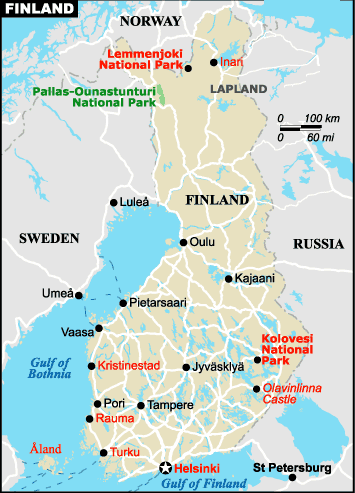| Official Name | Republic of Finland |
| Capital | Helsinki |
| Area | 338,142 Sq Km (130,557 Sq Mi) |
| Location | Finland is located in North Europe. |
| Geography | It is bound by Russia to the east, the Gulf of Finland to the south, the Gulf of Bosnia and Sweden to the west and Norway to the north. |
| Population | (1993) | (2015) |
| 5,190,785 | 5,471,753 | |
| Density | (1991) | (2015) |
| 16 persons per sq km | 16.2 persons per sq km | |
| (43 persons per sq mi) | (41.9 persons per sq mi) | |
| Urban-Rural | (1991) | (2015) |
| 61.6% urban | 69.2% urban | |
| 38.4% rural | 30.8% rural | |
| Sex Distribution | (1992) | (2015) |
| 48.6% male | 49.2% male (2,691,863) | |
| 51.4% female | 50.8% female (2,779,890) | |
| Life Expectancy at Birth | (1992) | (2015) |
| 70.8 years male | 78.7 years male | |
| 78.9 years female | 84.4 years female | |
| Age Breakdown | (1990) | (2015) |
| 19% under 15 | 16.4% under 15 (896,608) | |
| 21% 15 to 29 | 18% 15 to 29 (988,233) | |
| 25% 30 to 44 | 18.5% 30 to 44 (1,014,495) | |
| 17% 45 to 59 | 20.2% 45 to 59 (1,105,799) | |
| 13% 60 to 74 | 18.1% 60 to 74 (990,717) | |
| 5% 75 and over | 8.8% 75 and over (475,901) | |
| Birth Rate | (1990) | (2015) |
| 13.2 per 1,000 | 10.14 per 1,000 | |
| Death Rate | (1990) | (2015) |
| 10.1 per 1,000 | 9.59 per 1,000 | |
| Increase Rate | (1991) | (2015) |
| 3.1 per 1,000 | 0.55 per 1,000 | |
| Infant Mortality Rate | (1990) | (2015) |
| 5.8 per 1,000 live births | 1.7 per 1,000 live births |
Sleep Habits
Sleep/wake schedule
The Finnish population goes to sleep around 11:00PM and wakes up around 6:35 AM. They sleep on average 7 hours 13 minutes. On week ends or days off, they sleep about 55 minutes more than on week days.
Insomnia
- One on 9 individuals has difficulty falling asleep
- One on three individuals has a disrupted sleep
- One on 9 individuals wake up too early in the morning
- One on 9 individuals feels sleep is not refreshing
One individual on 8 complained about the quality or quantity of his or her sleep. This does not mean that all these individuals are insomniacs: only one on 9 individuals has a diagnosis of insomnia.
REFERENCES
- Ohayon MM, Partinen M. Insomnia and global sleep dissatisfaction in Finland. J Sleep Res. 2002;11(4):339-46.

